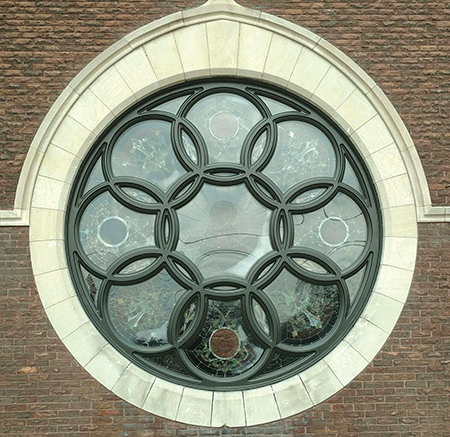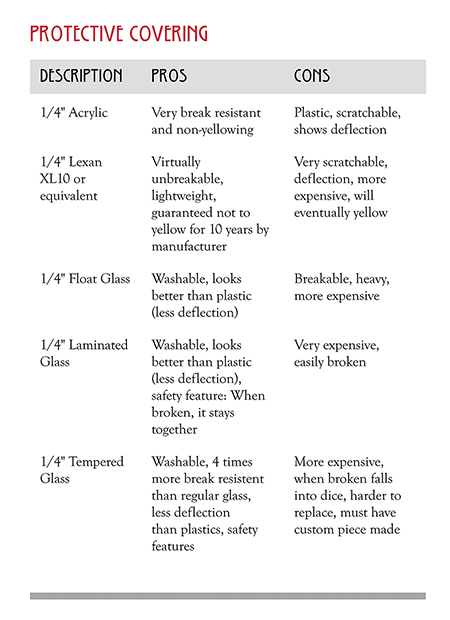
By John Phillips
Just think how wonderful it would be if, once your stained glass
windows were installed or restored, they simply stayed in pristine condition. That would mean little heat or air-conditioning loss through them, and no vandalism or weather elements damage.
Actually, this is a possibility: To maintain the original condition of the windows, and to preserve their aesthetic, consider installing a protective glazing system.

The purpose of installing protective coverings, or glazing, over stained glass windows often varies from church to church. Usually, however, it’s a combination of three objectives:
• To protect the windows from the weather, accidents or vandalism
• To eliminate drafts
• To better insulate the church.

Protective covering is integral to preserving our nation’s historic stained glass. Proper installation includes sufficient dead air space, venting, choice of material, frame and millwork repair, type and setting of divider bars, as well as the application of the correct type of sealant.
For more than 60 years, Associated Crafts® & Willet Hauser Architectural Glass® has specialized in the installation of transparent protective covering systems for windows old and new. Read on for an overview of what to look for (and what to avoid) when planning for your own protective glazing.
Sealant
The sealant must be a non-acidic cure; otherwise, it won’t react with the lead correctly and will quickly deteriorate.
Sealants must be able to adhere to a variety of surfaces, including metal, glass, plastic and masonry. For years, companies sealed plastics with straight silicone, not realizing that the seal would break within a year, allowing water to penetrate the covering systems. This leakage continued for years, creating severe damage to the windows and their frames.
Non-vented installation
Some in the industry today advocate for not using any venting in their protective covering installations. However, the majority of studios still recommend venting. The only non-vented installation we consider is if there’s a thermo-barrier frame and a sealed protective unit of insulated glass.
Venting decreases heat buildup and promotes airflow that helps dry and reduce the potential for condensation. With quality vents and innovative installation techniques, the installation is attractive.
To maximize the positive effects of venting, it’s important that the vents are properly positioned. Venting should be installed at the bottom and top to create airflow as heat rises. Associated Crafts®/Willet Hauser® uses an in-frame, proprietary system called Klear-Flo®. This is a customizable system that allows us to address the specific needs of the window.

Bending
The main drawback to the installation of protective covering has always been its appeal. Visually, many studios’ installations haven’t been attractive.
To correct this lack of appeal, some studios within the industry bend the divider bars to closely match the existing millwork. This provides the client with an improved look on the exterior of the building and allows the installation to be outset, thus protecting the framing or millwork while remaining attractive.
Other companies who lack these bending capabilities offer the in-setting of covering only. Though aesthetically appealing, it leaves the building with no protection to its framing and sets up the client for eventual costly maintenance.
It’s important to ask your provider for an in-depth explanation of these options specific to your building.

What type of protective covering?
Depending on your needs and budget, multiple types of protective covering are available. To assist you in deciding which type of covering is best for your project, refer to the table at right. Also, be sure to ask your consultant for a more in-depth look at the many options.
The takeaway
A properly installed protective glazing system will allow your valuable stained glass windows to maintain their aesthetic and historic integrity. Avoid unnecessary and premature stained glass repair and restoration by installing a protective glazing system now.
For a more in-depth look into choosing a protective covering system, and to view a helpful guide to the various elements of protective covering, download the Stained Glass Window Project Guide at www.willethauser.com.
John Phillips is Founder & CEO of Associated Crafts® & Willet Hauser Architectural Glass® — the largest studio in North America — headquartered in Winona, MN. The firm has served more than 20,000 churches and institutions in the last century. For more information, visit their website or call (800) 533-3960.



Looking to make our beautiful stain glass windows be seen from the outside!
Hello, We are considering installing protective windows at our church (St. Mary, Star of the Sea) in New London, CT. Are you willing to send an estimate of the cost of installing your product on our church? Any information and/or advice you can share would be greatly appreciated. Sincerely, James
Such an amazing article, keep up the good work. Thank you so much for sharing.
Need a cover for a window